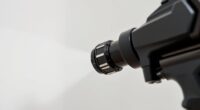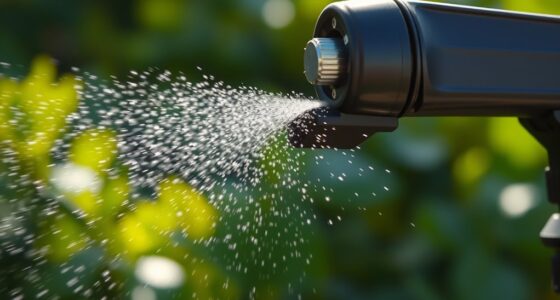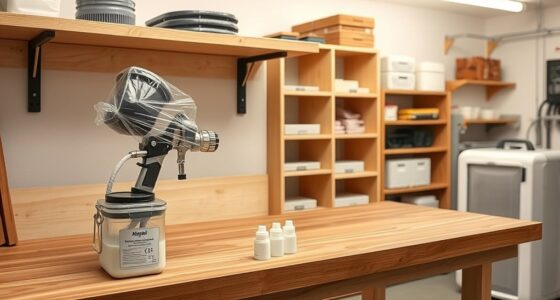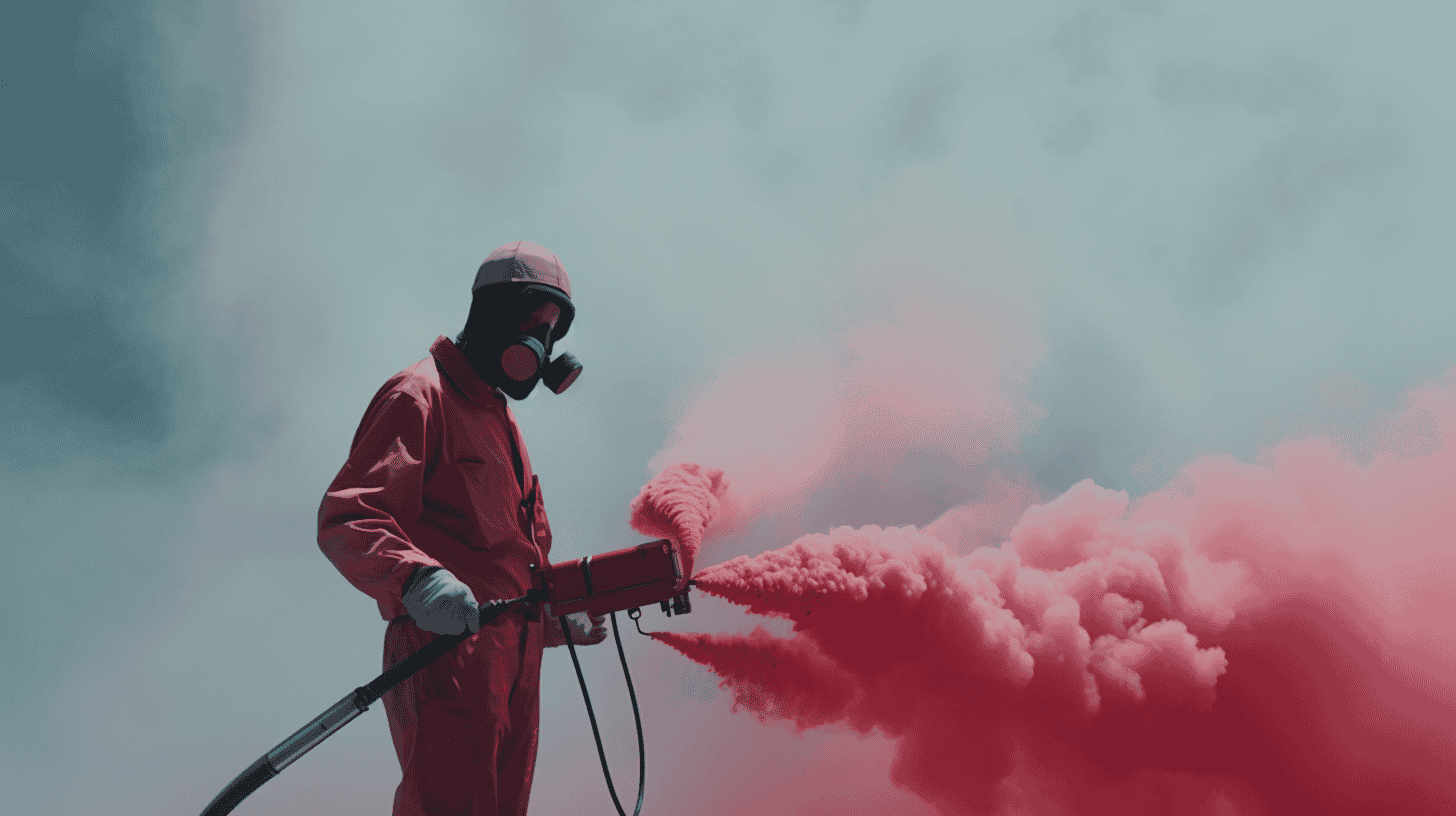You should replace your pump packing whenever you notice leaks, drips, or decreased spray pressure during operation. Unusual noises, vibrations, or visible damage also signal worn or damaged packing. Frequent re-priming and inconsistent spray patterns are signs to check the packing condition. Keep an eye on how often you use your sprayer and follow manufacturer’s recommendations to prevent problems. If you want to make sure your pump stays in top shape, there’s more to think about below.
Key Takeaways
- Replace pump packing when leaks or drips are visible during operation.
- Address decreased pressure and inconsistent spray patterns promptly.
- Replace packing if you hear unusual noises or vibrations from the pump.
- Inspect for cracks, tears, or hardening signs indicating worn or damaged packing.
- Follow manufacturer-recommended maintenance intervals, especially after prolonged or heavy use.
Signs of Leaking or Dripping During Operation
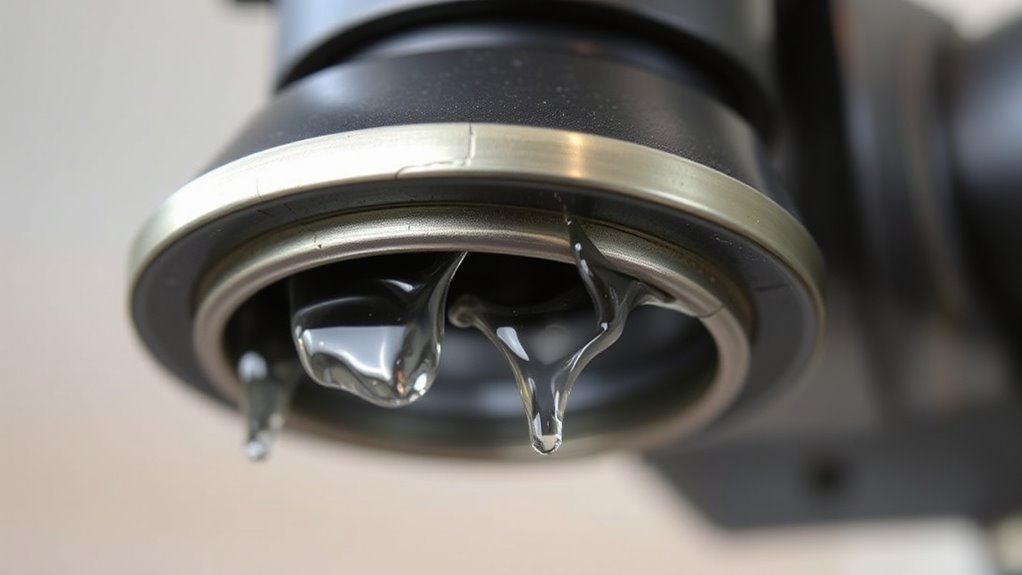
When your airless sprayer starts leaking or dripping during operation, it’s a clear sign that the pump packing may be worn or damaged. Poor packing material quality can cause faster deterioration, leading to leaks. If you notice constant dripping or fluid seeping from the packing area, don’t ignore it. These leaks often develop when the packing material no longer seals properly, which can happen before reaching the recommended replacement intervals. Regularly inspecting your pump and understanding the quality of your packing material helps you catch issues early. Additionally, the automation of maintenance checks can help identify wear before leaks become severe. If leaks persist, it’s a sign you need to replace the pump packing promptly to prevent further damage and guarantee maximum spray performance. Proper maintenance extends your sprayer’s lifespan and maintains consistent operation. Being aware of vetted top-quality replacement parts can ensure you select durable and reliable packing materials, and choosing appropriate packing can improve the longevity of your equipment. Regularly consulting manufacturer guidelines and recommended replacement schedules can further help in maintaining optimal performance.
Decreased Pressure and Spray Pattern Issues

Leaking or dripping during operation can be a sign that your pump packing is worn, but it can also lead to other issues like decreased pressure and inconsistent spray patterns. When you notice these problems, it’s time to perform a pump seal inspection. Worn packing material durability reduces the seal’s effectiveness, causing pressure drops. You might see uneven spray patterns or inconsistent flow. To diagnose, check for:
- Reduced pump pressure
- Uneven spray distribution
- Visible wear or damage in the packing area
- Leaks during operation
- Changes in spray pattern consistency
Incorporating digital literacy strategies can help you better understand and troubleshoot these issues effectively. Understanding maintenance schedules and proper inspection techniques can prevent unexpected failures. Staying informed about automation’s role in business intelligence can also improve your ability to interpret performance data related to your sprayer. Proper inspection techniques, including visual assessment, are essential for identifying early signs of wear. Addressing these signs early helps prevent further damage. Using predictive maintenance tools can enhance your ability to anticipate when replacements are needed. Replacing worn pump packings restores proper pressure and spray quality, ensuring your sprayer performs ideally.
Unusual Noises or Vibrations From the Pump

Unusual noises or vibrations from your pump often indicate that something isn’t functioning correctly within the sealing or packing components. These sounds may result from insufficient pump lubrication, which causes increased friction and stress on the packing. It’s essential to guarantee proper lubrication to prevent wear and reduce noise. Additionally, operator training plays a crucial role; improper handling or incorrect assembly can lead to misaligned or damaged packings, causing vibrations. Regularly check for abnormal sounds and listen for knocking or rapping noises, which signal potential issues. Addressing these early can prevent more serious damage and extend the life of your pump. Proper pump maintenance and understanding of financial aspects can also help allocate resources effectively for timely replacements. Monitoring pump performance regularly can help identify early warning signs before major failures occur. Incorporating preventive maintenance strategies further reduces the risk of unexpected breakdowns and ensures consistent operation. Being aware of wear and tear patterns can also assist in predicting when replacements are necessary.
Visible Wear or Damage on the Packing Material

Visible wear or damage on the packing material is a clear sign that your pump may need attention. During visual inspection, look for cracks, tears, or flattening that indicate material deterioration. Damage can compromise the seal, leading to leaks or pressure loss. If you notice any of these signs, it’s time to consider replacing the packing. Keep an eye out for:
- Cracks or tears in the packing material
- Flattened or compressed packing
- Excessive wear or thinning
- Discoloration or hardening
- Visible debris or contamination
Addressing these issues promptly prevents further damage and maintains ideal pump performance. Regular visual inspections help catch deterioration early, saving you from more extensive repairs or downtime later. Additionally, understanding pump maintenance best practices can extend the lifespan of your equipment, especially when considering upgrades or repairs to components like packing material. Proper maintenance routines also include checking for proper lubrication, which can further reduce wear and prolong component life. Incorporating protective styles during operation can also help minimize physical stress on the packing, further enhancing longevity. Being proactive with routine checks can significantly improve overall pump efficiency and reliability.
Increased Need for Frequent Re-priming

As your pump begins to lose prime efficiency, you’ll notice it takes longer to get the sprayer back up to speed. Air leaks around the packing often signal this issue, making re-priming more frequent. Addressing these leaks early can save you time and prevent more serious problems down the line. Regular inspection of seal integrity and proper maintenance practices can help identify potential issues before they escalate.
Loss of Prime Efficiency
Have you noticed that your airless sprayer requires more frequent re-priming than before? This loss of prime efficiency often signals worn pump packings. You might observe inconsistent spray patterns or difficulty maintaining pressure. To troubleshoot, check:
- Seal compatibility; worn seals cause air leaks affecting prime
- Pump calibration; improper settings can lead to prime loss
- Worn or damaged packings, which compromise the seal
- Air leaks around the packing area
- Blockages or debris in the fluid path
Replacing pump packings restores proper seal integrity, reducing re-priming frequency. Ensuring the packings fit correctly and maintaining proper pump calibration are key steps. When these components wear, air infiltrates the system, undermining prime efficiency and increasing downtime. Addressing these issues promptly keeps your sprayer running smoothly.
Air Leaks Indications
Increased need for re-priming often signals air leaks around the pump packing or seals. You might notice spray inconsistencies or frequent priming resets. Check for leaks at the packing area, as worn or incompatible packing material can cause air ingress. To troubleshoot, consider pump seal alternatives made from compatible materials to guarantee a proper seal.
| Packing Material | Compatibility Concerns | Seal Alternatives |
|---|---|---|
| Graphite | High chemical resistance | Viton or Teflon seals |
| PTFE (Teflon) | Lower friction, chemical resistance | Buna-N or Neoprene |
| Rubber (Nitrile) | Limited chemical resistance | Urethane or elastomer seals |
Choosing the right packing material guarantees a tight seal, reducing the need for frequent re-priming and preventing costly leaks.
Frequency of Use and Duration of Projects
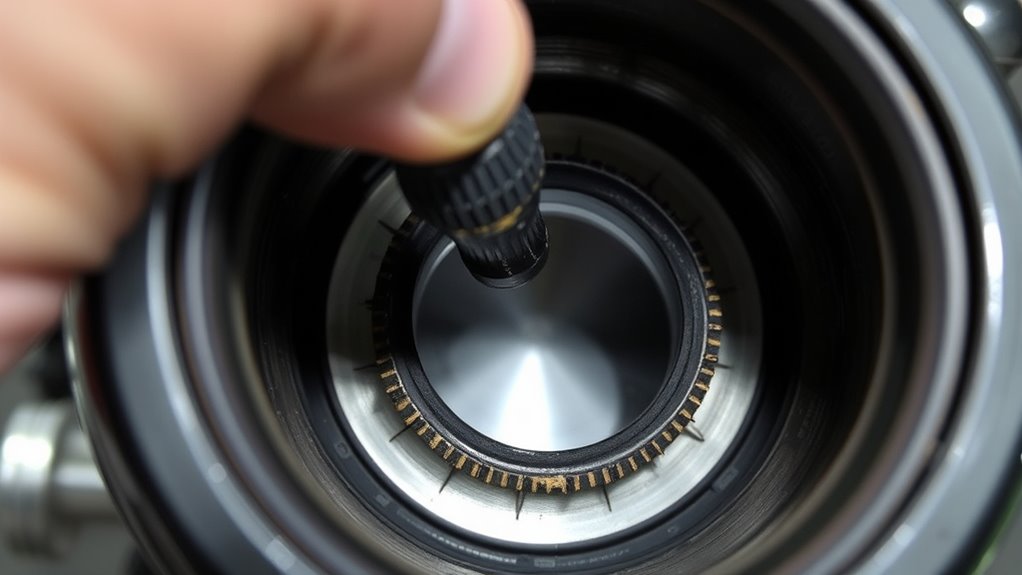
The frequency with which you use your airless sprayer and the length of your projects directly impact how often you’ll need to replace pump packings. If you’re tackling large projects regularly, the packings wear faster, especially if you’re still gaining operator experience. Shorter projects or occasional use mean less wear, extending their lifespan. Consider these factors:
- Large project size accelerates wear and tear
- Prolonged use increases packing degradation
- Less experienced operators may cause faster damage
- Frequent use demands more frequent inspections
- Shorter projects reduce overall stress on pump packings
Being mindful of how often and how long you operate helps you plan maintenance better. Proper technique and experience also play a role in minimizing unnecessary wear, saving you time and costs over the long run.
Routine Maintenance Intervals and Manufacturer Recommendations

Following manufacturer recommendations for maintenance intervals guarantees your airless sprayer operates efficiently and reduces the risk of premature pump packing wear. Adhere to suggested lubrication frequency to keep the packing material types properly lubricated, preventing unnecessary friction and damage. Different packing materials, such as Teflon or rubber, require specific maintenance schedules for peak performance. Regular inspections should be part of your routine, with adjustments made based on usage intensity and environmental conditions. Manufacturers often provide recommended intervals for replacing or servicing pump packings, which help avoid leaks, pressure loss, or equipment failure. Sticking to these guidelines ensures your sprayer functions smoothly, extends its lifespan, and minimizes downtime caused by unexpected repairs. Always consult your equipment manual for precise maintenance intervals tailored to your specific model.
Frequently Asked Questions
How Long Does a Typical Pump Packing Last Before Replacement?
The lifespan of a pump packing varies based on usage and maintenance, but generally, it lasts between 1,000 to 2,000 hours of spray equipment longevity. Regular pump packing maintenance helps prevent leaks and extends its service life. Keep an eye on pressure drops or leaks, as these signs indicate it’s time for replacement. Proper care ensures your sprayer operates efficiently and reduces downtime during your projects.
Can Improper Installation Cause Premature Packing Failure?
Think of your pump packing like the heart of your sprayer—if it’s installed wrong, it’s like a heart with a faulty valve. Improper installation can cause premature packing failure, turning maintenance errors into costly troubles. When installation issues arise, they strain the packing, leading to leaks and early wear. You need to make certain of proper setup, because a well-installed packing keeps your sprayer running smoothly and extends its lifespan.
What Are the Risks of Delaying Packing Replacement?
Delaying packing replacement risks increased packing deterioration, which can lead to spray inconsistencies and equipment damage. As the packing wears, you might notice leaks or uneven spray patterns, forcing you to work harder and waste material. Over time, this can cause costly repairs or even sprayer failure. To avoid these issues, it’s best to replace the packings promptly, ensuring your sprayer operates smoothly and maintains consistent, high-quality results.
Are There Specific Types of Pump Packings Recommended for Certain Fluids?
You should choose pump packings based on fluid compatibility and sealing materials. Different fluids, like acids or solvents, require specific sealing materials to prevent leaks and damage. Always check the manufacturer’s recommendations for fluid compatibility to guarantee you select the right packing. Using incompatible materials can cause premature wear or failure, so matching the sealing materials to your fluid type is crucial for ideal sprayer performance and longevity.
How Does Temperature Affect the Lifespan of Pump Packings?
Temperature effects play a significant role in your pump packing’s lifespan. High temperatures can accelerate material degradation, reducing durability, while low temperatures may cause the packing to become brittle and crack. You should monitor operating temperatures closely and select packing materials suited for your specific conditions. Proper temperature management helps maintain material durability, preventing early failure, and ensures your airless sprayer functions efficiently over time.
Conclusion
Knowing when to replace your pump packing keeps your sprayer running smoothly, like a well-oiled machine. Ignoring signs is like ignoring a small crack in a dam—you risk flooding your project. Stay attentive to leaks, pressure drops, or strange noises, and replace the packing before they grow into bigger issues. With regular care, your sprayer will continue to deliver flawless finishes, turning each project into a masterpiece rather than a battle against unwelcome surprises.

